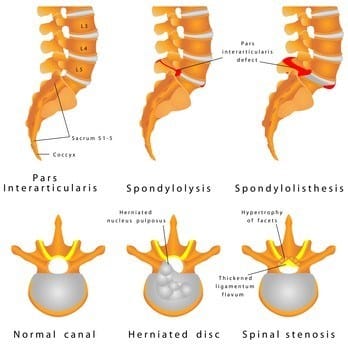SPONDYLOSIS AND SPONDYLOLISTHESIS
Spondylosis
Spondylosis is referring to the osteoarthritic changes of multiple spinal vertebra at the level of the discs. If severe, it may cause pressure on nerve roots which then causes pain, parasthesia, or muscle weakness in the limbs. Use of this term indicates that the facet joints at the back of the vertebrae are not necessarily involved.
Spondylolisthesis
This describes the anterior (forward) displacement of a vertebra in relation to the vertebrae below. Spondylolithesis often contributes to spinal stenosis. Most commonly, its severity is graded using a lateral x-ray. The measurements of the distance from the posterior (back) edge of the superior (above) vertebral body to the posterior edge of the adjacent inferior (below) vertebral body is reported as a percentage of the total superior vertebral body length: Grade I is 0-25%, Grade II is 25-50%, Grade III is 50-75%, Grade IV is 75-100% . Fredrickson, et al. demonstrated that the spondylolytic defect is usually acquired between the ages of 6 and 16 years, and that the slip often occurs shortly thereafter. Once the slip has occurred it rarely continues to progress. It may or may not be symptomatic, but it is significant because abnormal biomechanical stresses cause a greater likelihood of disc degeneration and associated osteoarthritic changes at this level.




